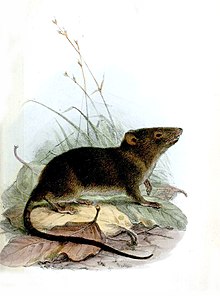Dusky caenolestid
| Dusky caenolestid | |
|---|---|
 |
|
| Scientific classification | |
| Kingdom: | Animalia |
| Phylum: | Chordata |
| Class: | Mammalia |
| Infraclass: | Marsupialia |
| Order: | Paucituberculata |
| Family: | Caenolestidae |
| Genus: | Caenolestes |
| Species: | C. fuliginosus |
| Binomial name | |
|
Caenolestes fuliginosus Tomes, 1863 |
|
| Subspecies | |
|
|
 |
|
| Range of the dusky caenolestid | |
| Synonyms | |
|
Caenolestes obscurus Thomas, 1895 |
|
Caenolestes obscurus Thomas, 1895
C. tatei H. E. Anthony, 1923
Hyracodon fuliginosus (Tomes, 1863)
The dusky caenolestid (Caenolestes fuliginosus), also known as Tate's shrew opossum, is a shrew opossum from South America. The dusky caenolestid is characterized by a dark brown coat with a lighter underbelly, soft and thick fur, and a loosely haired tail. A nocturnal animal (active mainly at night), the dusky caenolestid lives on trees and feeds on insects and small invertebrates and vertebrates. It occurs in alpine and páramo forests in northern and western Colombia, Ecuador, and western Venezuela. The IUCN classifies this shrew opossum as least concern.
The dusky caenolestid is one of the four members Caenolestes, and is placed in the family Caenolestidae (shrew opossums). It was first described by English zoologist Robert Fisher Tomes as Hyracodon fuliginosus in 1863. It was given its present binomial name by English zoologist Oldfield Thomas in 1895. In the latter part of 20th century, scientists believed that Caenolestes is closely related to Lestoros (the Incan caenolestid). Over the years, it became clear that Lestoros is morphologically different from Caenolestes. A 2013 phylogenetic study showed that the Incan caenolestid and the long-nosed caenolestid (Rhyncholestes raphanurus) form a clade sister to Caenolestes. The cladogram below is based on this study.
Gray short-tailed opossum (Monodelphis domestica)
...
Wikipedia

